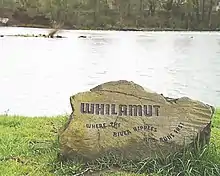Kalapuyan languages
Kalapuyan (also Kalapuya) is a small extinct language family that was spoken in the Willamette Valley of Western Oregon, United States. It consists of three languages.[1]
| Kalapuya | |
|---|---|
| Ethnicity | Kalapuya people |
| Geographic distribution | Northwest Oregon |
| Linguistic classification | Penutian ?
|
| Glottolog | kala1402 |
 | |
Family division
Kalapuyan consists of
- 1. Northern Kalapuya † (also known as Tualatin–Yamhill)
- 2. Central Kalapuya † (several dialects, including Santiam)
- 3. Yoncalla † (also known as Southern Kalapuya)
Genetic relations

One of the boulders engraved with Kalapuyan words along the paths of east Alton Baker Park in Eugene, Oregon; this one is next to the Willamette River: Whilamut (meaning, Where the river ripples and runs fast)
Kalapuyan is usually connected with the various Penutian proposals, originally as part of an Oregon Penutian branch along with Takelma, Siuslaw, Alsea and Coosan.[2] A special relationship with Takelma had been proposed, together forming a "Takelma–Kalapuyan" or "Takelman" family.[3][4][5][6] However, an unpublished paper by Tarpent & Kendall (1998)[7] finds this relationship to be unfounded because of the extremely different morphological structures of Takelma and Kalapuyan.
Proto-language
Below is a list of Proto-Kalapuyan reconstructions by Shipley (1970):[8]
no. gloss Proto-Kalapuyan 1 all *pu- 2 bad *khaskha 3 big *pala 4 bird *twi(ː)ca 5 bite *yiːk 6 black *muː 7 blood *nu 8 blow *puː- 9 bone *ca 10 burn *y- 11 cold *tuːku 12 come *ma- 13 come - 14 cut - 15 dig *hu- 16 dog *tal 17 drink *kʷh- 18 dry *chakkaluː 19 dull *tu- 20 dust *skuːp 21 earth *nuwa 22 eat *kʷVnafu 23 egg *pha 24 eye *kʷhillaːk, *kʷhalliːk 25 fall 26 father *-fa- 27 father *maːma 28 fear *n- 29 fear *yakla 30 feather *lunka 31 few *puː(n) 32 five *waːn 33 flower *puːk 34 four *tapa 35 fruit *kayna 36 give *tiː 37 good *suː 38 grass *luːkʷa 39 green *ci- 40 guts *niːya 41 hair, head *kʷaː 42 hand *laːkʷa 43 he *kʷawk 44 hear *kapt 45 heart *-uːpna 46 heavy *kayt 47 hot *ʔuːk 48 I *chi 49 ice *tic 50 kill *tah- 51 know *yukhu 52 lake *paːɫ 53 leaf *takhVɫ 54 left *kay 55 liver *paw 56 long *puːs 57 louse *t- 58 man *ʔuːyhi 59 many - 60 meat *muːkhi, *muːkʷhi 61 mother *naːna 62 mountain *maːfuː 64 name *kʷat 65 neck *puː- -k 66 new *pa(n)ɫa 67 nose *nuːna 68 not *waːnk 69 old *yuː(k) 70 one - 71 other *wana 72 path *kawni 73 person *mim 74 pierce *twa- 75 push *t- 76 red *c- -l 77 river *cal 78 rope *cal 79 round *(wi)luː 80 saliva *ta(w)f 81 say *na(ka) 82 sea *minlak 83 see *huːthu 84 sew *-aːkʷaː(t) 85 short *-u(w)pna 86 sing *kawt 87 sit *tastu 88 sit *yuː 89 sky *yank 90 sleep, lie *way 91 smell *h- 92 snake *(t)kaː 93 snow *-uː(p)paː(y)k 94 split *plVk 95 stand *taːp 96 stone *taː 97 straight *yalk 98 suck - 99 sun *pyan 100 swell *kuːf 101 swim *kʷay(n) 102 tail *tkuː 103 they *k(ʷ)i(n)nVk 104 thick *fip 105 thin *kliʔk 106 think *m- -t 107 this *kʷus(a) 108 this *haːs(a) 109 thou *maː(ha) 110 three *psin 111 throw *kawi 112 tie *takt 113 tongue - 114 tooth *ti 115 tree *watVk 116 two *kaːmi 117 walk *ʔiːti 118 wash *kaw(a)ɫ 119 wash *cawC 120 water *pk(y)aː 121 we *stuː 122 what *ʔa(k)kaː 123 white *maw 124 wind *-iːʈwa 125 wing *wa(ː)n 126 ye *mV(t)tiː 127 year *miːcwa
References
- Berman, H. (1990). An Outline of Kalapuya Historical Phonology. International Journal of American Linguistics, 56(1), 27-59.
- Sapir, E. (1921). A Characteristic Penutian Form of Stem. International Journal of American Linguistics, 2(1/2), 58-67.
- Frachtenberg, L. (1918). Comparative Studies in Takelman, Kalapuyan and Chinookan Lexicography, a Preliminary Paper. International Journal of American Linguistics, 1(2), 175-182.
- Swadesh, M. (1965). Kalapuya and Takelma. International Journal of American Linguistics, 31(3), 237-240.
- Shipley, W. (1969). Proto-Takelman. International Journal of American Linguistics, 35(3), 226-230.
- Kendall, D. (1997). The Takelma Verb: Toward Proto-Takelma-Kalapuyan. International Journal of American Linguistics, 63(1), 1-17.
- cited in: Mithun, Marianne. (1999). The languages of Native North America, pp. 432-433. Cambridge: Cambridge University Press.
- Shipley, William. 1970. Proto-Kalapuyan. In Swanson, Jr., Earl H. (ed.), Languages and Cultures of Western North America, 97-106. Pocatello: Idaho State University Press.
Further reading
- Campbell, Lyle. (1997). American Indian languages: The historical linguistics of Native America. New York: Oxford University Press. ISBN 0-19-509427-1.
- Goddard, Ives (Ed.). (1996). Languages. Handbook of North American Indians (W. C. Sturtevant, General Ed.) (Vol. 17). Washington, D. C.: Smithsonian Institution. ISBN 0-16-048774-9.
- Jacobs, Melville (1945). Kalapuya Texts. University of Washington Publications in Anthropology. Vol. 11. Seattle: University of Washington.
- Mithun, Marianne. (1999). The languages of Native North America. Cambridge: Cambridge University Press. ISBN 0-521-23228-7 (hbk); ISBN 0-521-29875-X.
- Sturtevant, William C. (Ed.). (1978–present). Handbook of North American Indians (Vol. 1-20). Washington, D. C.: Smithsonian Institution. (Vols. 1-3, 16, 18-20 not yet published).
External links
| Wiktionary has a list of reconstructed forms at Appendix:Proto-Kalapuyan reconstructions |
- The Verbal Morphology of Santiam Kalapuya (Northwest Journal of Linguistics)
This article is issued from Wikipedia. The text is licensed under Creative Commons - Attribution - Sharealike. Additional terms may apply for the media files.
